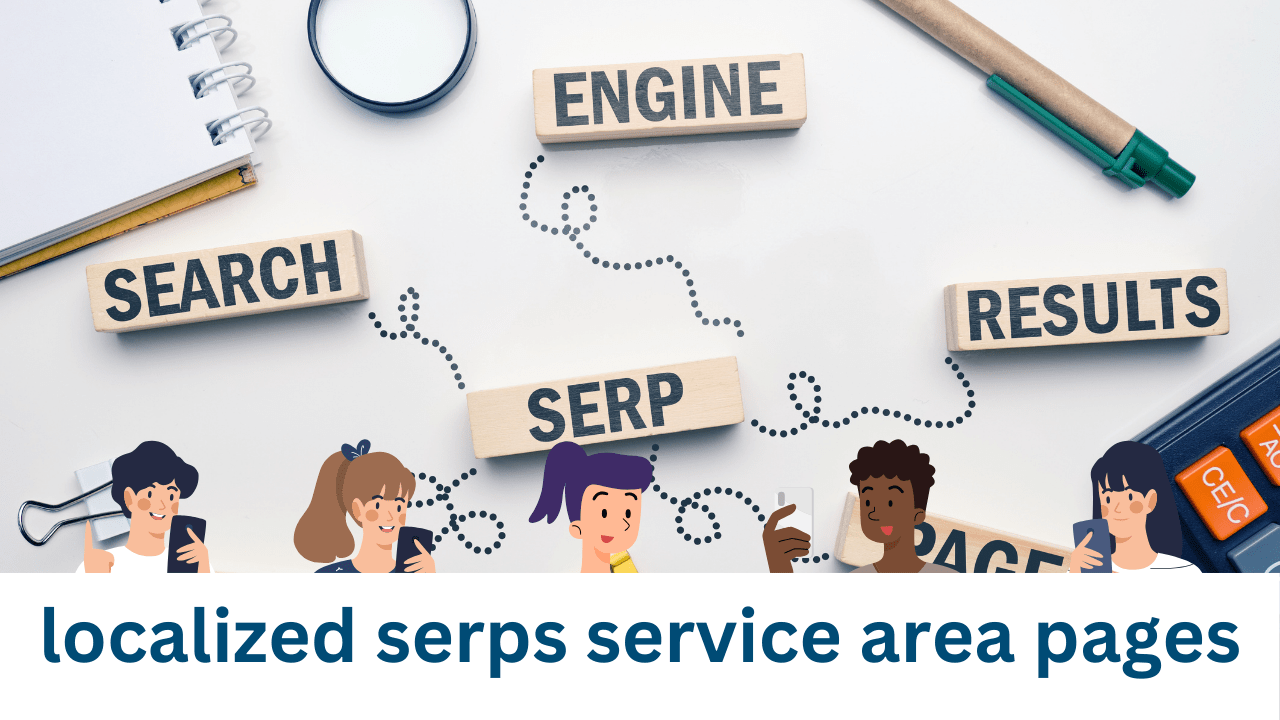Localized SERPs and Service Area Pages : In the ever-evolving world of SEO, localized search engine results pages (SERPs) and service area pages (SAPs) have become crucial tools for businesses aiming to attract local customers. Understanding how to leverage these tools can significantly boost your local visibility and drive more traffic to your business. Let’s explore the intricacies of localized SERPs and SAPs, and how you can use them to your advantage.
What are Localized SERPs?
Definition and Explanation
Localized SERPs are search engine results that are tailored to a user’s specific geographic location. When someone searches for a service or product, search engines like Google prioritize results that are relevant to the user’s local area. This means that a bakery in New York will show up in searches made by users in New York, but not necessarily in searches made by users in California.
How They Impact Local Businesses
For local businesses, appearing in localized SERPs is a game-changer. It means being visible to potential customers who are geographically close and more likely to visit or contact your business. This increased visibility can lead to higher foot traffic, more inquiries, and ultimately, more sales.
The Role of Service Area Pages
Understanding Service Area Pages
Service area pages are web pages that detail the specific geographic areas a business serves. These pages are essential for businesses that operate in multiple locations or offer services in “Localized SERPs and Service Area Pages ” a wide geographic area. They help search engines understand where your business operates, which in turn helps your business show up in relevant local searches.
Benefits of SAPs for Local SEO
Service area pages enhance local SEO by providing detailed information about the areas you serve. This can improve your ranking in localized SERPs and make it easier for potential customers to find you. Additionally, these pages can help you capture a larger share of local search traffic by targeting specific keywords related to each service area.
Key Elements of Effective Service Area Pages
Detailed Location Information
Your service area pages should include comprehensive details about each location you serve. This includes the name of the area, zip codes, “Localized SERPs and Service Area Pages ” neighborhoods, and any relevant landmarks. The more specific you are, the better.
Local Keywords and Phrases
Incorporate local keywords and phrases throughout your content. This helps search engines understand the geographic relevance of your page. For example, if you are a plumber serving Los Angeles, you might use keywords like “Los Angeles “Localized SERPs and Service Area Pages ” plumbing services” or “plumbers in LA.”
Customer Reviews and Testimonials
Including customer reviews and testimonials specific to each service area can build trust and credibility. Positive feedback from local customers can also improve your local SEO ranking.
Read More :Grant Cardone Net Worth 2024: How He Got Super Rich [Case Study]
High-Quality Images and Maps
Visual content such as high-quality images and maps can enhance the user experience and provide valuable information to potential customers. Maps showing your service areas can be particularly useful.
How to Create Service Area Pages
Researching Target Areas
Start by researching the areas you want to target. Understand the demographics, local interests, and common search terms used by residents in those areas. This will help you create content that resonates with your audience.
Writing Compelling Content
Write unique, engaging content for each service area page. Highlight the specific services you offer in each area and why customers should “Localized SERPs and Service Area Pages ” choose your business. Use a conversational tone to make your content more relatable and engaging.
Optimizing for Mobile Users
Ensure your service area pages are mobile-friendly. With an increasing number of users searching for services on their mobile devices, having a responsive design is crucial for user experience and SEO.
Using Structured Data
Implement structured data markup to help search engines better understand the content of your service area pages. This can improve your chances of appearing in rich snippets and other enhanced search results.
Optimizing Service Area Pages for SEO
On-Page SEO Techniques
Use on-page SEO techniques such as optimizing title tags, meta descriptions, headers, and URL structures. Ensure your content includes relevant keywords naturally and provides valuable information to users.
Local Link Building Strategies
Build local backlinks by partnering with other businesses, sponsoring local events, and getting listed in local directories. “Localized SERPs and Service Area Pages ” High-quality local backlinks can significantly boost your local SEO efforts.
Using Google My Business
Optimize your Google My Business (GMB) listing by keeping your information accurate and up-to-date. Encourage customers to leave reviews and respond to them promptly. A well-maintained GMB listing can improve your visibility in local searches.
Monitoring and Analyzing Performance
Regularly monitor and analyze the performance of your service area pages using tools like Google Analytics and Google Search Console. Track metrics such as page views, bounce rates, and conversion rates to identify areas for improvement.
Common Mistakes to Avoid
Duplicate Content
Avoid using duplicate content across multiple service area pages. Each page should have unique, original content that provides value to users.
Ignoring User Experience
Don’t overlook the importance of user experience. “Localized SERPs and Service Area Pages ” Ensure your pages load quickly, are easy to navigate, and provide a seamless experience across all devices.
Overlooking Mobile Optimization
Mobile optimization is crucial for local SEO. Make sure your service area pages are fully responsive and provide an excellent user experience on mobile devices.
Case Studies: Successful Service Area Pages
Small Business Example
A small local bakery created individual service area pages for each neighborhood it served. By including detailed descriptions, local keywords, and customer testimonials, they saw a significant increase in local search traffic and in-store visits.
Large Corporation Example
A nationwide plumbing service created service area pages for each city and town they operated in. By optimizing these pages for local SEO and using structured data, they improved their ranking in localized SERPs and saw a substantial increase in online bookings.
The Future of Localized SERPs and SAPs
Emerging Trends
As technology advances, localized SERPs and service area pages will continue to evolve. Personalization and user intent will play a larger role in how search results are displayed.
The Impact of Voice Search
Voice search is becoming increasingly popular, and it’s changing the way people search for local businesses. Optimizing your service area pages for voice search can help you stay ahead of the curve.
The Role of Artificial Intelligence
Artificial intelligence (AI) is transforming SEO. AI-powered tools can help you optimize your service area pages more effectively by “Localized SERPs and Service Area Pages ” providing insights into user behavior and search trends.
Tools and Resources for Local SEO
Best SEO Tools for Local Businesses
Utilize SEO tools like Moz Local, SEMrush, and BrightLocal to manage and optimize your local SEO efforts. These tools can help you track rankings, analyze competitors, and find new opportunities.
Resources for Staying Updated
Stay informed about the latest trends and best practices in local SEO by following industry blogs, attending webinars, and participating in online forums. Resources like Search Engine Journal and Moz Blog are excellent places to start.
Conclusion : Localized SERPs and Service Area Pages
Localized SERPs and service area pages are essential for businesses looking to attract local customers. By understanding how to create and optimize these pages, you can improve your visibility in local searches and drive more traffic to your business. As the digital landscape continues to evolve, staying updated with the latest trends and best practices will ensure your local SEO efforts remain effective.
FAQs :Localized SERPs and Service Area Pages
What is the primary purpose of a service area page?
The primary purpose of a service area page is to provide detailed information about the specific geographic areas a business serves, helping to improve local SEO and attract local customers.
How often should I update my service area pages?
It’s recommended to update your service area pages at least once a quarter or whenever there are significant changes in your service areas or offerings.
What are the best practices for local keyword research?
Best practices for local keyword research include using tools like Google Keyword Planner, analyzing competitor keywords, and focusing on long-tail keywords that include specific locations.
Can I use the same content for multiple service area pages?
No, each service area page should have unique content to avoid duplicate content issues and to provide value to users in each specific area.

